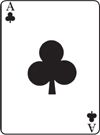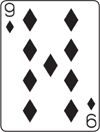How to Memorize Anything (40 page)
Read How to Memorize Anything Online
Authors: Aditi Singhal,Sudhir Singhal
Tags: #Self-Help, #Meditations

2 stands for
Monday
.
Note: When the final total is more than 7, divide it again by 7 and the remainder thus obtained corresponds to the code of the day.
IN CASE OF LEAP YEAR
If the given year is a
leap year
and the months are
January or February
, then reduce 1 day from the day calculated.
Example 4:
23
rd
Feb., 1976
2 + 4 + 0 + 4 = 10
10 ÷ 7 gives remainder as 3 and 3 stands for Tuesday.
Ideally the day should be Tuesday, but 1976 is a leap year, so as per the rule for calculating the day in the leap year, we reduce one day, i.e. instead of Tuesday, the day would be Monday.
So, 23
rd
Feb, 1976 was a
Monday
.
H
OW
D
O
Y
OU
K
NOW
I
T
’
S A
L
EAP
Y
EAR
?
As soon as you hear the months of January and February, immediately check if it is a leap year
(if the given year is divisible by 4, it means it’s a leap year).
If it is, then reduce one day from the day calculated.
If the year is leap year but the months are from March to December, then there is no need for any adjustment. We make adjustment only in the months of January and February.
With practice, you can tell the day of any date within 5 seconds.
Try finding out day of the following dates:
- 8
th
Nov., 1956 - 19
th
Nov., 2005 - 2
nd
Oct., 1869 - 3
rd
Jan., 1984 - 7
th
April, 2008
24
MEMORIZING LONG SERIES OF NUMBERS
I
n this chapter, we are going to share an amazing secret that will enable you to be a star among your family and friends. It is a game of numbers we play in most of our seminars. We ask the audience to give us random numbers
(say about 100 numbers)
that we note down on a board. Immediately after that we recall the whole sequence of those numbers with our eyes closed. We even tell the numbers in reverse order. The audience usually breaks into an impromptu applause, amazed at our feat.
Let us share the secret of doing that with you.
Suppose this is the list of numbers you have to memorize:
923456599126788505481953989572
You might think that memorizing such a long number will take time but it’s really very easy.
- Break the above sequence of numbers in 15 pairs of 2-digit each. Use phonetic method to convert them into words.
- Now, memorize these 15 words in a sequence using chain method or hide-and-seek method.
Let’s understand it by following the given steps:
Step 1:
Break the long series into pairs of 2 digits

Step 2:
Decode the pairs with the help of phonetic peg codes
(as done in
chapter 13
, using the advance peg system)
| 92 | BuN |
| 34 | aMiR |
| 56 | LeeCH |
| 59 | LaB |
| 91 | BaT |
| 26 | NehRu |
| 78 | KoFee |
| 85 | FiLe |
| 05 | SaLe |
| 48 | RooF |
| 19 | TaP |
| 53 | LiMe |
| 98 | B.F. |
| 95 | BelL |
| 72 | KoNe |
Thus to memorize a sequence of 30 digits in a series, you have to memorize only 15 words.
These words can be memorized in a sequence using:
(a) Chain Method
(b) Hide-and-Seek Method
Step 3:
(a) Memorizing using Chain Method
Visualization:
Visualize that there are lots of
buns
.
Amir Khan
comes and starts eating them. All of a sudden, a big
leech
comes out of his mouth. The leech is taken to a
lab
to experiment. The lab is full of
bats
. One bat is gifted to
Nehruji
. He starts drinking the
coffee
. The coffee alls on the
file.
The file is put on
sale
. While the sale was going on, the
roof
collapsed.
A tap
was opened to wash everything but instead of water,
lime
water started coming out. I gave this limewater to my
best friend (B.F.),
who was holding a gigantic
bell
. Inside the bell, there were lots of
cones
.
Now repeat this visualization in your mind and try to recall the words you have memorized. And write them in sequence in the space given below:
- buns
Now, while visualizing the words in your mind, try to decode these words by their respective numbers:__________________________________________
(b) Memorizing using Hide-and-Seek method
After decoding the numbers into words or images in step 2 above, now recall the list of your hiding places created in the ‘hide-and-seek method’ chapter. Then associate each word with the hiding locations one by one in a sequence.
After all the images have been associated with their respective hiding places, visualize the stops in a sequence and try to decode each associated word into number as you move on in your journey.
Tip: You may recall the sequence in the reverse order as well just by visualizing your hiding places starting from the end and moving one place backwards each time, during your recall.
With practice, you will soon be able to directly decode the word images into numbers as you visualize your associations in mind.
APPLYING MEMORY TRICKS TO YOUR WORKING LIFE
You may argue what’s the need to memorize 30 random number sequences or what’s the use of mastering calendar of 500 years when a calendar can be accessed on a mobile also?
These memory stunts not only help you amaze your friends and family and become a hero in front of them, they will also motivate you to apply these methods in your day-to-day life and increase your self-confidence. For example, the calendar trick can be used to
plan your events in the future
and check if that falls on a specific day or on a weekend. Similarly, memorizing a list of long numbers can be helpful in
remembering credit card numbers
(16 digits) or bank account numbers or any other numerical data.
Also, these activities are a good workout for your brain and help you improve your concentration as well. They are the practical application of the methods learnt in the previous chapters. Once you start practicing these activities,
your mind will be conditioned to memorize information automatically using these methods instead of depending on latest gadgets.
So what are you waiting for? Prepare yourself to earn the title of
‘Memory King’
or
‘Memory Queen’
from your peers.
25
MEMORIZING PLAYING CARDS
P
laying cards offer much more than an amusing pastime. They can be used for endlessly fascinating memory practice. You can learn to memorize a complete deck of 52 cards and amaze your friends with this memory stunt.
Cards are, by their very nature, difficult to memorize, in much the same way as numbers are. To memorize a deck of 52 cards in a sequence, we need a system for
assigning a particular word and image to each card
, thereby immediately making them more individual, more tangible, and more memorable.
There are different ways to do this, and you shouldn’t think that you have to do it in a certain way only:
- King of Hearts could be your dad.
- Queen of Hearts could be your mom.
- 5 of Hearts could be your daughter Sharon because she is 5-years-old and you love her
(hearts could mean love for you). - Jack of Hearts could be a Joker holding a big heart.
- Ace of Clubs can be visualized as a big tree.

- Four Jacks could be four top sports stars.
- Four Queens could be four top actresses as the queens.
- Four Kings could be four former presidents.
- The Jack, Queen, and King of each suit can be personalities from different fields.
- Shape of Nine of Diamonds looks like H, which can further be visualized as Harry Potter.

There are advantages of this method, but to make things a bit easier, instead of memorizing 52 new peg words, you can use a bunch of the peg words you have already memorized for 0 to 99.
Although the choice of peg words depends on you, here we are sharing with you the words and images that we have assigned to 52 cards.
MEMORY PEGS FOR CARDS: ACE TO 10
For each card, one word is assigned. That word comprises two parts:
- The first part represent the first letter of the suit:
C
for
Clubs
♣,H
for
Hearts
♥,S
for
Spades
♠, andD
for
Diamonds
♦ - The second part of the word represents the
phonetic peg
given to the value of card.
Example 1:
